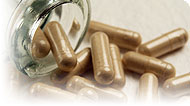Gluten Free
What does following a gluten-free diet mean? That you're embarking on an easy diet with a wide range of health-promoting effects. Instead of dwelling on what you’re giving up, consider that you’re going to enjoy a whole new world of delicious food options to meet your special dietary needs. You’ll be eating seasonally, choosing more fresh fruits and vegetables, focusing on meats, seafood, poultry, legumes, lentils, corn, and rice, and discovering fascinating ancient grains such as quinoa, amaranth, and millet. You’ll be able to eat potatoes, eggs, most cheeses, even chocolate (!)—and enjoy them without guilt because you’ll be taking good care of your body. In fact, you’ll probably end up eating—and feeling—better than ever!
Visit this page for more information about living Gluten Free
---
We carry a large variety of gluten free items, the brands listed below represent just some of the offerings we carry















More Diets
Gymnema

How It Works
The hypoglycemic (blood sugar-lowering) action of gymnema leaves was first documented in the late 1920s.1 This action is attributed to members of a family of substances called gymnemic acids.2, 3 Gymnema leaves raise insulin levels, according to research in healthy volunteers.4 Based on animal studies, this may be due to regeneration of the cells in the pancreas that secrete insulin,5, 6 or by increasing the flow of insulin from these cells.7 Other animal research shows that gymnema can also reduce glucose absorption from the intestine,8 improve uptake of glucose into cells, and prevent adrenal hormones from stimulating the liver to produce glucose, thereby reducing blood sugar levels.9, 10
Other animal studies have shown that extracts of gymnema leaves can lower serum cholesterol and triglycerides and prevent weight gain,11, 12, 13, 14 but these effects have not been tested in humans. When placed directly on the tongue, gurmarin, another constituent of the leaves, and gymnemic acid have been shown to block the ability in humans to taste sweets.15, 16
How to Use It
Clinical trials with diabetics in India have used 400 mg per day of a water-soluble acidic fraction of the gymnema leaves. The gymnemic acid content of this extract is not clear. A recent preliminary trial in the United States reported promising results in a group of type 1 and type 2 diabetics who took 800 mg per day of an extract standardized for 25% gymnemic acids.17 Traditionally, 2 to 4 grams per day of the leaf powder is used.
Copyright © 2025 TraceGains, Inc. All rights reserved.
Learn more about TraceGains, the company.
The information presented by TraceGains is for informational purposes only. It is based on scientific studies (human, animal, or in vitro), clinical experience, or traditional usage as cited in each article. The results reported may not necessarily occur in all individuals. Self-treatment is not recommended for life-threatening conditions that require medical treatment under a doctor's care. For many of the conditions discussed, treatment with prescription or over the counter medication is also available. Consult your doctor, practitioner, and/or pharmacist for any health problem and before using any supplements or before making any changes in prescribed medications. Information expires December 2025.











